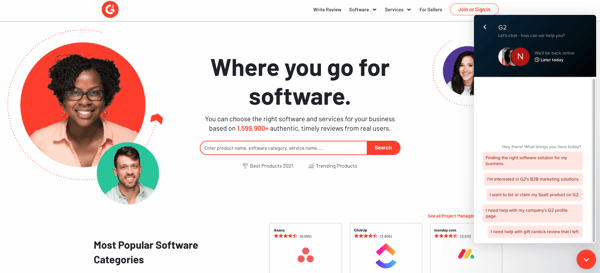February 7, 2022
 by Keerthi Rangan / February 7, 2022
by Keerthi Rangan / February 7, 2022

Consumer demand for personalized experiences is at an all-time high.
Big data, marketing automation, and other technologies make it easy for companies to track their customers' behaviors and preferences. Organizations that provide specialized, personalized experiences see more than just a boost in consumer satisfaction – they see significant growth of their bottom line.
When it comes to customer communication, customers want to choose how they communicate with you. Traditional marketing channels are slowly becoming less effective and even damaging. Businesses either have to invest in expensive marketing initiatives or find new ways to connect and engage with customers.
Business messaging gives companies a way to improve the customer experience at scale. With business messaging, companies can communicate with customers on their preferred channel to deliver a great customer experience and help consumers interact with companies for pre- and post-sales activities.
Organizations use business instant messaging software for direct and group conversations between employees and customers. These tools also enable rapid communication among team members.
Business messaging allows companies to connect with consumers on their preferred messaging channels. It's a powerful strategy for building strong customer relationships and driving profitable business outcomes.
Companies use business messaging to provide a great customer experience, improve their marketing and sales efforts, and drive revenue growth by creating stronger brand loyalty among the consumer base.
Business messaging, also known as asynchronous messaging, is no longer a new concept. With the advent of messaging apps, changing buyer behavior and expectations, and increased competition, businesses use newer communication channels to connect with customers.
Short messaging service (SMS), or text messaging, is the most commonly used messaging medium. We've all received shipping notifications, advertising offers, promotional campaigns, and reminders from companies. These are the types of interactions we often associate with business messaging.
But business messaging isn't just one-sided, and it's not restricted to texting. Business communications can happen on any digital platform where your consumers already spend their time, and it's expected that such practices enable two-way conversational interaction.
Businesses have found that in order to succeed, they need to engage their customers using smartphones and other messaging-enabled devices. Consumer preferences have forced companies to make essential changes that affect which channels they use for customer engagement.
Companies now deliver a personalized experience through real-time communications channels like instant messaging (IM), social media messaging, and in app messaging software. Customers engage with companies using instant messaging applications such as Facebook Messenger, WhatsApp, WeChat, and LINE.
Here are a few ways businesses communicate with their customers in real time:
There are many business messaging platforms, including:
From social networking sites to SMS, messaging has become an essential component of daily life and has significantly altered how we connect with others. Facebook has 2.9 billion monthly active users, WhatsApp has 2 billion, and 50.6% of Android TikTok app owners use the video-sharing app daily.
But it's hard to overlook the reality that, when utilized appropriately, these conversational channels offer enhanced engagement and competitive differentiation for consumer-facing businesses. Team communication itself, not the medium, is valued in conversational messaging.
Below are three ways business messaging improves your business prospects.
Each user journey starts with discovering a new product that satisfies a certain need. Addressing product inquiries, clarifying features, or responding to customer issues allows companies to convince buyers that they're making the right decision.
Business messaging provides a quick, easy, and seamless way for customers to communicate with brands, regardless of their stage in the customer journey. It also enables organizations to shift from one-way to two-way dialogue with buyers.
Allowing users to interact in a two-way discussion using a platform they're most comfortable with increases engagement and improves the experience.
Time is every customer's most important asset. They don't like being put in a queue and having to wait on the phone to talk with an agent unless it's vital. Such hurdles are eliminated with business messaging.
Using messaging in conjunction with existing channels reduces both incoming and outbound engagements and allows customers to interact with the brand from anywhere at any time. Whether they're at home or halfway around the world, customers can interact instantly and get the solutions they need in real time.
Most companies have similar priorities: stay available to consumers on their chosen channels to enhance quality service, promote brand engagement, improve customer experience, and relieve the burden on customer care agents.
Companies can achieve these objectives by communicating with consumers through multiple channels.
Adopting an omnichannel messaging approach helps companies achieve their goals and boost potential savings. The purpose of omnichannel messaging is straightforward: to keep the dialogue going even when the customer switches platforms.
Unlike traditional business communication, omnichannel messaging allows users to choose which channel to communicate on, giving them more choice during the interaction. For example, customers can be sent to a web page by SMS or an interactive voice response (IVR) can route them to a WhatsApp Chat.
While business messaging has become a crucial component of most consumer marketing strategies, it isn't always a clear mode of communication. There are several platforms, countless rules, and numerous variations amongst them.
Live chat, often known as web chat, integrates a chat function directly onto your website. Customers often visit your website for one of two reasons: to buy something or receive an answer to a question. They should be able to accomplish both with live chat support.
Live chat is often deployed as a widget in the bottom corner of a website and triggers when visitors click on it. Alternatively, a pop-up window can urge users to start a discussion. Businesses employ live chat software to manage web chats for the company site.

Source: G2.com
Companies can use live chat solutions for various reasons, including customer service, technical assistance, sales, and marketing. It's also used to generate leads.
Although live chat windows are available on a website 24 hours a day, this doesn't imply that agents must be ready to answer inquiries at all times. Offline modes allow website users to submit queries or concerns that are handled by a chatbot or an agent during business hours.
Top 5 live chat software providers:
*These are the five leading live chat software providers from G2's Winter 2022 Grid® Report.
Business text messaging has grown in popularity to communicate with consumers. Unlike other messaging applications, text messaging does not require an internet connection. Anyone with a phone plan can receive text messages, making it a readily accessible alternative for your customers.
Businesses also choose SMS marketing because these campaigns have far higher open rates than email marketing. Text messaging requires a cellular network to deliver texts and includes SMS, Multimedia Messaging Service (MMS), and text messages.
SMS marketing software enables companies to interact with their buyers via text messages. Businesses also use SMS marketing to deliver bulk SMS campaigns and participate in two-way discussions with customers.
Top 5 SMS marketing software providers:
*These are the five leading SMS marketing software providers from G2's Winter 2022 Grid® Report.
Email is still one of the most successful ways for businesses to connect with buyers. It's also one of the most widely employed digital channels for customer care. Personalizing your content is critical for increasing client engagement via email. This requires maintaining accurate audience segmentation based on demographic profiles and behavioral insights gathered from past interactions.
The major disadvantage with email is its own popularity. Every day, our inboxes are inundated with emails because they are overused, and people simply default to them, even when there are better communication channels for particular situations.
Email marketing software helps companies send commercial messages to groups of people via email.
Top 5 email marketing software providers:
*These are the five leading email marketing software providers from G2's Winter 2022 Grid® Report.
Social customer support is extremely successful because it allows consumers to reach out to your organization on their most-used channels. Using social media to answer customer issues or complaints is known as social media customer service.
Businesses use conversational marketing software to engage potential customers with personalized, one-on-one conversations that route to specific product recommendations, offers, or customer service requests. Conversational marketing software helps companies discover potential buyers on social networking sites, respond to concerns or queries, determine the most suitable products, and send consumers to payment gateways or sales representatives to complete transactions.
Offering omnichannel services via social media is difficult for large and small companies. Smaller businesses struggle to keep up with consumer requests due to a lack of personnel. Large companies with high levels of engagement find it challenging to connect with every user.
Top 5 conversational marketing software providers:
*These are the five leading conversational marketing software providers from G2's Winter 2022 Grid® Report.
All business messaging systems have some features in common. As the market becomes more competitive, some vendors add extra communication and productivity capabilities to help differentiate their products. Some of these features are:
Nowadays, every organization, whether its small, medium, or large, uses a messaging platform. Choosing the most dependable business messaging platform is the first step toward effective marketing. Here are some crucial things to consider while selecting an ideal platform for your company.
Business messaging enables efficient and simplified interactions. As a result, introducing a business messaging platform opens up new communication channels for consumers wherever and whenever needed.
Below are some of the most common business messaging use cases.
Some businesses excel at providing exceptional customer service. But for others, the customer experience consists of a series of awkwardly disjointed contacts with various employees who repeatedly ask you to explain your problem.
It's easy to criticize agents, but the fact is that client interactions are frequently compartmentalized between tickets. Even the finest agents struggle to get the complete picture. Business messaging makes this process much more manageable.

Source: Twitter
Conversations through messaging apps are linear and not threaded by subject, as they are in emails. Simply scrolling up is enough to identify a consumer, grasp the context, and make an informed choice about assisting them.
Your conversion rate is a clear measure of the number of customers who discover value when they land on your website. Increasing the number of conversions requires optimizing your site with engaging content and a clear call to action (CTA).
A prospective consumer will most certainly fill out a lead form on your website, and your odds of having a meeting are mainly dependent on how quickly you respond to that first encounter.
Unlike phone conversations and emails, employees can resume the dialogue through business messaging channels at any moment by simply scrolling up and reviewing the context of the entire chat. This allows sales teams to handle more prospects in the same way that customer service agents do. Business messaging is an incredibly appealing and cost-effective tool for driving sales conversions.
Customers are no longer interested in mass marketing strategies. They expect brands to personalize their offers and interactions, which is inconvenient for most businesses. However, this has huge business potential.
Messaging services make it easier for organizations to establish a presence on these apps and communicate with customers. Businesses can also include an inbound shortcode in marketing and promotional materials to entice prospective consumers to contact them for more information.

Keep up with what’s really going down in marketing with the G2 Tea newsletter. Subscribe here
Now more than ever, it's important for brands to start conversations with the people they want to reach, thanks to a rise in multi-channel and multi-device messaging. Business messaging is a vehicle for brands and businesses to own their customer experience, not beholden to an ad network or social platform. Business messaging applications allow users to engage with companies through web and social channels.
Follow these principles if you're new to messaging to provide the flawless experiences your consumers demand.
Businesses use business messaging services to digitalize their internal processes. Consumers are less dependent on phone calls and are increasingly inclined to use digital channels, which are easier to operate through bots and other self-service options.
Below are some advantages of business messaging platforms:
Using messaging platforms is almost second nature for most of us. They're so simple and entertaining that they're often the first place we go to share news, opinions, and information.
Unfortunately, offering effective and efficient customer service through social media introduces new obstacles for representatives who must interact with consumers in a new and more intimate way, and for managers who must balance resources, expenses, and company objectives.
Customers' desire to communicate with companies is growing, and there is no end in sight. They value quick messaging and effective customer service and expect it from businesses. Customers want real-time replies to their support questions.
With business messaging applications, you can provide consumers with a new way to contact you and build a positive customer experience while cutting costs.
Want to apply business messaging for internal communications? Read how to create a highly efficient, personal, and responsive communication approach with enterprise instant messaging.
Keerthi Rangan is a Senior SEO Specialist with a sharp focus on the IT management software market. Formerly a Content Marketing Specialist at G2, Keerthi crafts content that not only simplifies complex IT concepts but also guides organizations toward transformative software solutions. With a background in Python development, she brings a unique blend of technical expertise and strategic insight to her work. Her interests span network automation, blockchain, infrastructure as code (IaC), SaaS, and beyond—always exploring how technology reshapes businesses and how people work. Keerthi’s approach is thoughtful and driven by a quiet curiosity, always seeking the deeper connections between technology, strategy, and growth.
Whether you’re a business leader, partner, or team member, communication channels are your...
 by Angela Yurchenko
by Angela Yurchenko
Today’s teams are more connected.
 by Sam O'Brien
by Sam O'Brien
The business world never stops changing.
 by Mary Clare Novak
by Mary Clare Novak
Whether you’re a business leader, partner, or team member, communication channels are your...
 by Angela Yurchenko
by Angela Yurchenko
Today’s teams are more connected.
 by Sam O'Brien
by Sam O'Brien


